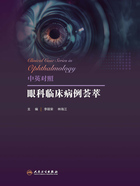
病例8 45岁女性,双眼异物感3个月
CASE 8 A 45-year-old female patient, with both eyes foreign body sensation for three months
见图1-12。See Fig. 1-12.

图1-12 角膜下方可见多个丝状物附着,结膜充血Fig. 1-12 Some f ilaments attached on the lower part of the cornea and palpebral conjunctival congestion
鉴别诊断
Differential Diagnosis
◎ 丝状角膜炎:原因不明,干眼是其主要的病因。角膜上皮的异常生长代谢和黏液的聚集是其病理基础,角膜表面形成黏丝样赘生物,患者伴有不同程度异物感、眼疼、畏光流泪等症状。
◎ Filamentary keratitis: The pathogeny of filamentary keratitis is still unknown and dry eye is the main possible cause. The abnormal growth and metabolism of corneal epithelium and the accu m ulation of mucus are its pathological basis. The corneal surface forms mucinous f ilamentous exc res cence. The patients frequently complain of different degrees of foreign body sensation, eye pain,photophobia and tearing.
◎ 角膜上皮剥脱:通常与外伤和眼部原有疾病(如角膜上皮基底膜营养不良)有关,症状与丝状角膜炎类似,但更为强烈。
◎ Corneal epithelial exfoliation: Corneal epithelial ex f oliation is usually related to trauma or the original diseases of the eye (such as corneal epithelial bas e ment membrane dystrophy). The symptoms are simi lar to but more severe than f ilamentary keratitis.
◎ 角膜异物:多有异物进眼史,裂隙灯检查可发现角膜上附着异物。
◎ Corneal foreign body: Mostly it has a history of injury that lead to some foreign bodies into eyes, which can be checked by the slit lamp.
病史询问
Asking History
◎ 疾病何时发生,是否反复。
◎ Asking the duration of disease, the history of recurrence.
◎ 是否患有其他眼部疾病,如病毒性角结膜炎、干眼等,是否有眼部手术史或长期配戴接触镜史。
◎ The history of other eye diseases (such as viral ke ratoconjunctivitis, dry eye, the history of eye surgery or longterm contact lens wearing).
◎ 是否有全身慢性疾病史和自身免疫病史,如类风湿性关节炎或干燥综合征,以及是否接受过放疗化疗。
◎ The history of systemic chronic diseases and autoimmunity(such as rheumatoid arthritis or Sjögren’s syndrome),chemotherapy and irridiation therapy for cancer patients.
检查
Examination
◎ 裂隙灯检查见角膜上单个或数个卷曲状的丝状物,长短不一,一端附着于角膜,另一端游离,并随瞬目运动弯曲移动,孟加拉红染色阳性。丝状物与角膜黏附牢固,用力眨眼后可能自行脱落,对应区域角膜上皮缺损,常合并角膜点状上皮糜烂或表层点状角膜炎(图1-12)。
◎ Slit lamp examination: Single or multiple curly f ilaments of different lengths can be seen on the cornea. One end of the f ilaments is attached to the cornea, the other end is free,bending and moving with the blink movement. Bengal red staining positive. Filaments adhere f irmly to the cornea.When blinking hard it may fall offand corneal epithelial defects in the corresponding area. It is often combined with corneal punctate epithelial erosion or superf icial punctate keratitis (Fig. 1-12).
实验室检查
Lab
◎ 红细胞沉降率(血沉)、类风湿因子、抗核抗体、抗SS-A抗体及抗SS-B抗体等排查患者是否有自身免疫系统疾病。
◎ Erythrocyte sedimentation rate (ESR), Rheumatoid factor(RF), antinuclear antibody, anti-SS-A antibody, anti-SS-B antibody, etc., are used to check whether patients have autoimmune diseases.
诊断
Diagnosis
丝状角膜炎。
Filamentary keratitis.
治疗
Treatment
◎ 去除诱因,积极治疗原发病;
◎ Remove the inducement and treat the primary disease actively.
◎ 在表面麻醉下擦除或剔除丝状物;
◎ Wipe or remove the f ilaments with topical anesthetic.
◎ 抗生素眼药水或眼药膏预防感染;
◎ Antibiotic eye drops or ointment.
◎ 人工泪液或自体血清减轻症状促进愈合;
◎ Artif icial tears or serum.
◎ 乙酰半胱氨酸减少丝状物黏性;
◎ Acetylcysteine.
◎ 角膜绷带镜减轻症状,减少复发。
◎ Bandage contact lens.
患者教育和预后
Patient Education & Prognosis
◎ 病因众多且不明确,需要积极寻找可能的原因,并积极予以治疗。
◎ The etiology is numerous and unclear. It is necessary to actively look for possible causes and actively treat them.
◎ 如果潜在病因持续存在,如干燥综合征或全身慢性疾病等,治疗困难且易复发。
◎ If the underlying etiology persists, such as Sjögren’s syndrome or chronic systemic diseases, it is difficult to treat and easy to relapse.
◎ 部分轻度患者可自愈,丝状物不可自行刮除,以免感染。
◎ Some mild cases can recovery with no treatment. But to avoid infection, it is important to advise the patients not to scrape the f ilaments themselves.